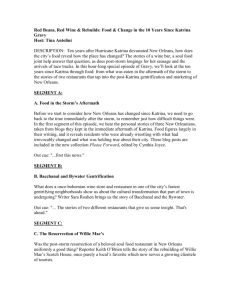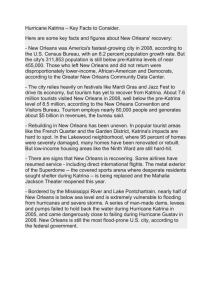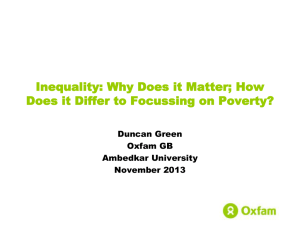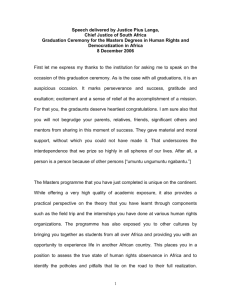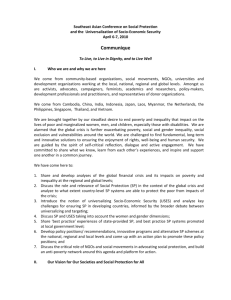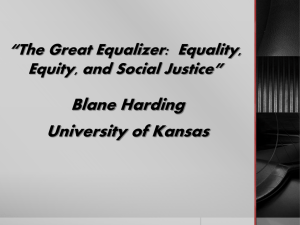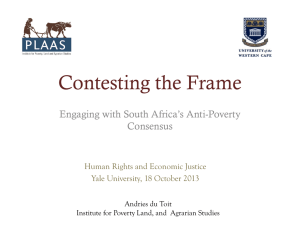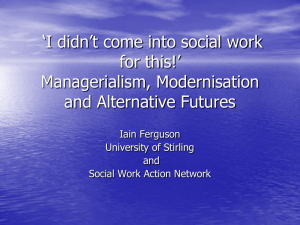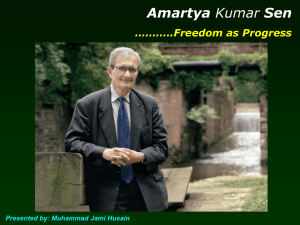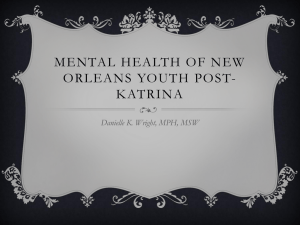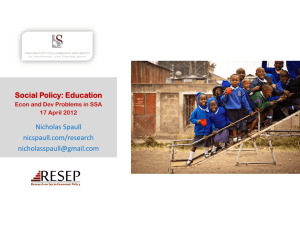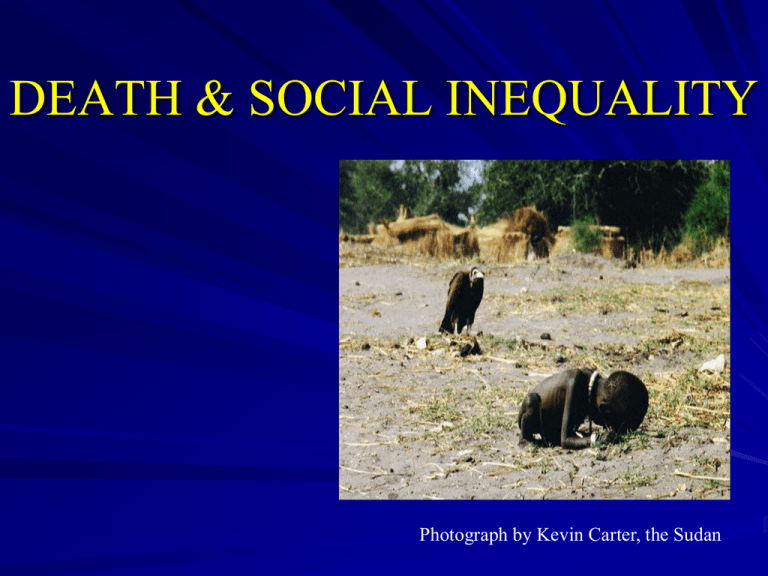
DEATH & SOCIAL INEQUALITY
Photograph by Kevin Carter, the Sudan
In Plagues and Peoples, historian William
McNeill speculates how the Indian caste
system developed as Indian civilization
encountered disease as they incorporated the
“forest people,” resulting in strict separation
of groups and taboos against physical contract
(p.91).
Children at their shanty homes built on top of tombs in a graveyard in
the northern Manila port district of Navotas, one of the world's most
densely populated areas.
Death as a Measure of Life
THE INEQUALITY OF LIFE CHANCES
Out of the 1,308 passengers
on board the Titanic in
1912, 416 survived. Taken
together, 60 percent of the
first class survived, 40
percent of the second, and
but 25 percent of the third.
The crew fared badly as
well, with only 24 percent
surviving.
And like the Titanic, it was the lower
classes who lived beneath the waterline in
New Orleans when Hurricane Katrina in
2005. Like the doomed lower class
passengers in 1912, these were the
individuals who disproportionately
perished.
Photograph by Thomas Dworzak
And what inferences do you make about social conditions
where death is routinely part of everyday life?
What a shocked world saw exposed in New Orleans
wasn't just a broken levee. It was a cleavage of race and
class, at once familiar and startlingly new, laid bare in a
setting where they suddenly amounted to matters of life
and death. Hydrology joined sociology throughout the
story line, from the settling of the flood-prone city,
where well-to-do white people lived on the high ground,
to its frantic abandonment.
--Jason DeParle. “What Happens to a Race Deferred” New York Times
(Sept. 4, 2005)
The evacuation plan was based on people
driving out of New Orleans. However, 35
percent of black households did not have
access to a car, compared to 15 percent of
whites.
There were stark contrasts between the nation’s
reactions to the Hurricane Katrina disaster as opposed to
the 9/11/01 terrorist attacks on New York City.
The final Trade Center steel girder left
standing was removed from Ground
Zero in May 2002.
New Orleans Ninth Ward 5 years after
Katrina.
Inequalities in the amount of life
of various social groups
In Scotland, a boy from the country's wealthiest
suburb has a life expectancy of 87.7 years, while a
boy born in the poorest area of Glasgow can
expect to die at 54.
A child born in Calton, in the East End of
Glasgow, is three times as likely to suffer heart
disease, four times as likely to be hospitalised and
ten times as likely to grow up in a workless
household than a child in the city's prosperous
western suburbs.
--Fraser Nelson. “A nation still divided by poverty and inequality.” The
Scotsman (Jan. 4, 2006)
“Empire at the End of
Decadence,” New York
Times (Feb. 18, 2011)
CDC, 2011
Factor by which uninsured children in U.S.
hospitals are more likely to die of their
injuries than are insured children: 2.
--Families USA/Harper’s Index (June 2007)
In October of 2007, John Tanner, chief of the
Department of Justice’s voting rights division,
caused a political firestorm. He was addressing
the National Latino Congresso in Los Angeles,
claiming how Photo ID restrictions at the
polling do affect the elderly and how that that's
a "shame." But, he added, minorities needn't
worry because "minorities don't become elderly.
The way that white people do. They die first."
THE RICH LIVE LONGER
Analyzing births, deaths, income and wealth
in England between 1250 and 1800, as
evidenced primarily by wills, Clark found on
average richer people were more likely to
marry than poorer people, they married at
earlier ages, they lived longer once they
were married, bore more children per year of
marriage, and their children were more
likely to survive and to bear children.
Apple’s Steve Jobs had a liver transplant in
2009. The billionaire’s story became a
parable of class privilege and the inequities
of the nation's transplant system. Jobs
relocated from his home in California to
Tennessee, where there is much less
competition for vital organs.
From the 1987 Whitehall study, a British survey of the mortality rates of civil
servants aged 20-64, all of whom had access to medical care and none impoverished.
Difference in life expectancy
between males and females,
blacks and whites in U.S.
1975-2000
--Source: National Vital Statistics Reports
50(15) (Sept. 16, 2002)
More than 886,000 deaths could have been
prevented between 1991 to 2000 if African
Americans had received the same care as
whites. The study estimates that technological
improvements in medicine -- including better
drugs, devices and procedures -- averted only
176,633 deaths during the same period.
--Steven H. Woolf, Robert E. Johnson, George E. Fryer, Jr, George Rust, &David Satcher.
“The Health Impact of Resolving Racial Disparities: An Analysis of US Mortality Data.”
American Journal of Public Health 2004 94: 2078-2081.
The infant mortality rate in America’s capital is
twice as high as in China’s capital…--the number of
babies who died before their first birthdays
amounted to 11.5 per 1,000 live births in 2002 in
Washington, compared with 4.6 in Beijing.
--Nicholas Kristof. “The Larger Shame.” New York Times (Sept. 6,
2005)
Why, even when controlling for socioeconomic differences, do whites outlive
their black counterparts?
Is it the stress of living in a whitedominated society?
The shooting deaths in 2005 at Red Lake High
School in Red Lake, Minnesota, revealed the
plight of American Indians on reservations.
Nationally, native American teens commit suicide
at three times the national rate and die in alcoholrelated incidents at 17 times the national average.
A state survey conducted in 2004 of 56 ninthgraders on the Red Lake Indian Reservation
showed that 81% of the girls and 43% of the boys
had considered suicide.
--Deborah Hastings. “Midwest death spree magnifies bleakness.” AP
(March 27, 2005)
CLASS-BASED IMPLICATIONS OF
THE HIGH COSTS OF DYING
Samuel Marshall, Kathleen M. McGarry, Jonathan S. Skinner. 2010. “The Risk of Out-of-Pocket Health Care Expenditure
at End of Life.” The NBER Bulletin on Aging and Health, Working Paper No. 16170.
Americans increasingly die when
they no longer can afford to pay
Health care spending in the last year of
life by the top 1 percent of Americans
is nearly twice the annual income of
the typical American household.
Across the country in
2009, coroners and
medical examiners
reported spikes in the
number of unclaimed
bodies and indigent
burials, with states,
counties and private
funeral homes having
to foot the bill when
families cannot.
A Kentucky funeral director wiping off a small marker
after a recent burial.
INTERNATIONAL
STRATIFICATION SYSTEMS
Captioned as “Just
another day in 3rd world
countries” at
http://www.crappycorn.com/20051010
.html .
WORLD SYSTEMS MODEL
Core-periphery dichotomy of world
economy
Periphery: low value-added raw
materials production
Semi-periphery: like E. Europe, where
capitalism exists with other modes
Core: high value-added production,
dominant capitalism
At the dawn of the new millennium,
according to the World Bank, of the planet’s
6 billion people about 1.2 billion people
were living below the poverty line of less
than one dollar per day, and almost 3.0
billion on less than two dollars per day.
According to a 2001 UN report (“Health and
Sustainable Development”) , poverty is and
will remain the number one killer worldwide.
“Poverty is an important reason that babies are
not vaccinated, clean water and sanitation are
not provided, drugs and other treatments are
unavailable, and mothers die in childbirth.”
Taken in Karamoja district, Uganda in April 1980, the
contrasting hands of a starving boy and a missionary.
The 1980 famine killed 21% of the population (and 60%
of the infants) and was one of the worst in history.
Between 1940 and 2004, 335 emergent
infectious diseases have arisen in human
populations. They largely occur where
population density is the greatest and over onehalf are caused by drug-resistant microbes.
Gini scores (0 = perfect equality, 1 =
perfect inequality with all income
going to one worker/family)
The larger the gap between rich and
poor in a society, the higher its overall
death rates from heart disease, cancer,
and murder.
--Barry Glassner, The Culture of Fear: Why Americans Are Afraid of the Wrong
Things
From International data sets, 2000-05
ECO-INEQUALITY
A typical computer monitor with a cathode ray tube
display contains 2-4 kilograms of lead, as well as
phosphor, barium, and hexavalent chromium. Other
toxic ingredients include cadmium in chip resistors
and semiconductors, beryllium on motherboards and
connectors, and brominated flame retardants in
circuit boards and plastic casings.
As much as 50-80 percent of U.S. electronic waste
collected for recycling is sent to Asia (mainly China,
India, and Pakistan) where workers are exposed to
toxic fumes, lung and respiratory irritants, and other
dangerous health threats.
--Radhika Sarin, Earthworks, in WorldWatch Institute
INEQUALITIES OF AGE
New York Times, Jan. 1, 2005
As of Jan. 1, 2007, more than 3,000 U.S. personnel have lost their lives in Operation
Iraqi Freedom. (Source, AP)
AP, Jan. 1, 2007
AP, Jan. 1, 2007

